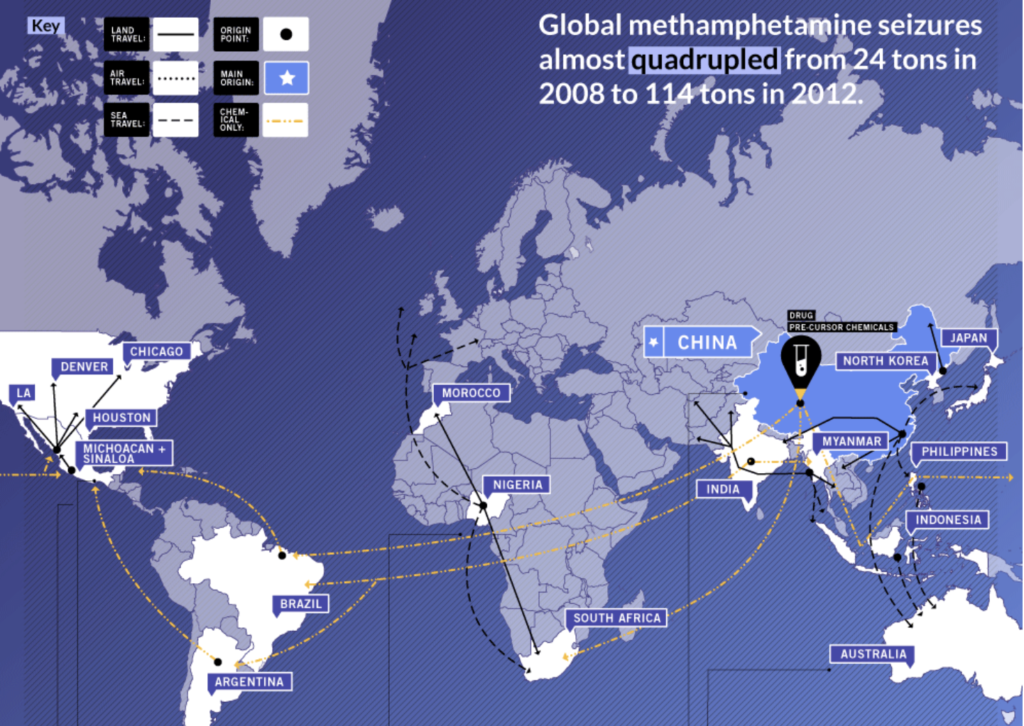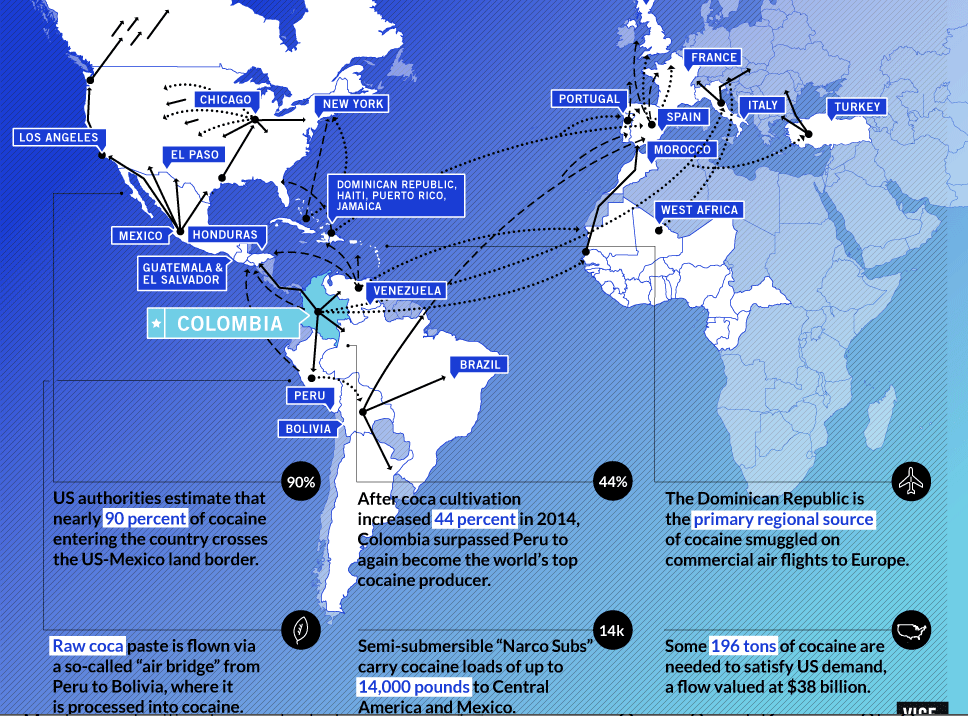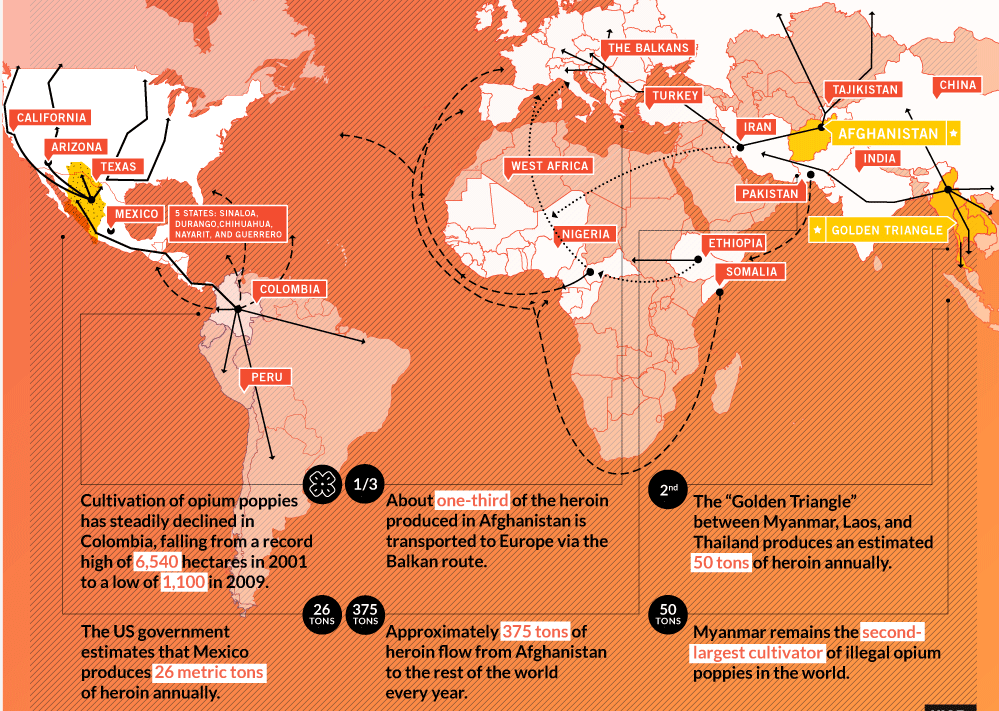Drug Trafficking Facts
Extreme drug abuse, addiction to pain, is prevalent around the world.
Worth billions in illegal trade, the major drugs – methamphetamines (meth), cocaine and heroin – have been wreaking havoc individually and collectively for years.
Another narcotic, fentanyl, about 100 time more toxic than morphine, is being mixed with cocaine and heroin, imported, and sold illegally with tragic consequences.
Here are some facts about fentanyl according to the Royal Canadian Mounted Police website (1):
“Fentanyl has been mixed with other drugs such as heroin and cocaine.
“It has been used in tablets made to look like prescription drugs.
“Overdoses have occurred where individuals were not aware they were consuming fentanyl.
“It is odourless and tasteless, and therefore hard to detect.
“It is often found in powder, pill, liquid and blotter form.
“2 milligrams of pure fentanyl (the size of about 4 grains of salt) is enough to kill the average adult.
“Unintentional exposure to pure fentanyl – touching or inhaling – can cause serious harm including death.
“Fentanyl-related deaths have been increasing in Canada.” (1)
****
Below is information about the drug trade around the world. Some of the statistics are from a few years ago.
Methamphetamines:
“Methamphetamine. . . has become one of the most popular — and profitable — illicit substances in nearly every corner of the world. From Australia and Asia to Africa and North America, meth is the poster drug for the global narco economy.
“The quantities of meth confiscated by authorities over the past decade reflect its rise. According to the UNODC {the United Nations Office on Drugs and Crime}, global meth seizures nearly quadrupled from 24 tons in 2008 to 114 tons in 2012. Meth seizures in Mexico increased from 341 kilograms in 2008 to 44 tons in 2012. In Australia, meth seizures soared by more than 400 percent in a single year, climbing from 426 kilograms in 2011 to 2,269 kilos in 2012.” (2)
Cocaine:
“In 1998, the last time the UN held a special gathering to discuss drug policy, the stated goal was ‘eliminating or significantly reducing the illicit cultivation of the coca bush, the cannabis plant and the opium poppy by the year 2008.’ Even in hindsight, at least part of that goal doesn’t seem entirely out of reach: Just a handful of Andean nations — Colombia, Peru, and Bolivia — are responsible for virtually the entire global supply of cocaine.” (3)
Where there has been a decrease in South American cocaine production, there has been an increase in other areas, in heroin production:
“Opium poppies can be found in nearly every region of the world, but they were introduced to Mexico in the late 1800s by Chinese immigrants. The plant it is now grown primarily by impoverished campesinos in mountainous parts of the states of Guerrero and Nayarit, and in the so-called Golden Triangle, a lawless region on the frontiers of Sinaloa, Durango, and Chihuahua. The Sinaloa Cartel controls most of the heroin production, and the organization has started to move from producing lower-quality ‘black tar’ heroin to higher-grade ‘China white’, which is more lucrative and prized by consumers in the northeastern US.
“For years, Colombia was the leading supplier of ‘China white’ in the US, but poppy production has steadily declined in the country over the last half-decade. Bargent, the Colombia-based organized crime expert, said Mexicans have stepped up to meet the American demand.
“The UNODC {the United Nations Office on Drugs and Crime} attributes the recent surge in heroin addiction in the US to ‘changes in the formulation of OxyContin, one of the main prescription opioids that are misused, as well as an increase in the availability of heroin and a decrease in its price in some parts of the country.’” (4)
Often fentanyl addiction can start with a prescription for painkillers, such as Oxycontin.
At the bottom of this post is a video describing the tragic death of a young person who was prescribed Oxycontin after a bad fall.
As it was stated above, fentanyl is also cut into heroin and cocaine by the traffickers and dealers.
Below is what happened in Estonia, why fentanyl addiction escalated there:
“The problem began in the late 1990s as hard times came to large swaths of Russia and its former satellites after the fall of communism. Although Estonia as a whole was charting a promising course, some areas of the country – such as the northeast – were hit hard by the collapse of its industrial base.
“It was an environment ripe for drug dealers to exploit. By 1999, between 15,000 and 20,000 people in the country of 1.3 million were hardened heroin addicts, fed by a reliable supply from the poppy fields of Afghanistan. Most were male, and most were under 25.
“The following year, when the Taliban imposed a ban on opium, the supply to the former Soviet republics was cut off. To fill the void, dealers began production and street distribution of synthetic opioids. ‘China White’ and ‘White Persian’ – street names for fentanyl and its molecularly similar cousin 3-methylfentanyl – were pushed to users who could no longer get heroin.
“Almost immediately, there was an epidemic of overdose fatalities.
“In 2002, 105 fatal overdoses from illicit drugs were reported – 90 per cent caused by fentanyl. Over the next 10 years, the toll topped more than 1,000, again almost all from fentanyl or 3-methyfentanyl, giving the country the highest overdose death rate per capita in the European Union. In 2012, when 170 deaths were reported, it became among the highest fatal overdose rates in the world.” (5)
Trafficking:
“Globalization has led to an explosion of drug trafficking. More than 420 million shipping containers traverse the seas every year, transporting 90 percent of the world’s cargo. Most carry legitimate goods, but authorities cannot inspect them all, and some are used to smuggle drugs — or just as importantly, the chemicals used to make meth and cheaply process coca leaves and opium poppies into cocaine and heroin. Airplanes, submarines, speedboats, trucks, tunnels — taken as a whole, the systems used to move illegal drugs around the world comprise a logistics network likely bigger than Amazon, FedEx, and UPS combined.”
“One recent development has seen more Afghan heroin — an estimated 35 metric tons per year — shipped across the Indian Ocean to parts of East and Southern Africa. The UNODC said it’s also becoming more common for heroin smugglers to use their networks to smuggle hashish, methamphetamine, and other illicit goods.
“To a certain extent, there has also been a shift in the focus of the trafficking routes themselves,” the UNODC wrote. ‘There is increasing evidence that routes traditionally used for smuggling one type of drug are now being used for smuggling other drug types.’”(6)
****
Below are shipping routes the drug cartels use (7) :

meth shipping routes

cocaine shipping routes

heroin shipping routes
Footnotes
(1) Royal Canadian Mounted Police website:http://www.rcmp-grc.gc.ca/en/what-is-fentanyl
(3) Loc. cit.
(4) Loc. cit.
(5) Estonia: https://www.theglobeandmail.com/news/national/estonias-cautionary-fentanyl-tale-for-canada/article30512811/